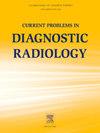Age is more than just a number – Tailoring radiologic practice for the geriatric population
IF 1.5
Q3 RADIOLOGY, NUCLEAR MEDICINE & MEDICAL IMAGING
引用次数: 0
Abstract
The growing elderly population is transforming healthcare delivery, with radiology playing a central role in diagnosing and managing diseases in older adults. As patients age, they develop distinct imaging characteristics due to physiological changes and comorbidities, which can complicate diagnosis and treatment across radiologic subspecialties. This article explores key geriatric imaging considerations in neuroradiology, cardiothoracic, abdominopelvic, musculoskeletal, oncologic, and interventional radiology, emphasizing how each subspecialty faces unique challenges in distinguishing normal aging from pathology.
Despite progress in geriatric care across many medical disciplines, radiology has lagged in its adaptation—lacking specific training programs, imaging protocols, and geriatric-focused guidelines. This article calls for the integration of geriatric content into radiology curricula and the development of tailored imaging templates and multimodality strategies.
By aligning imaging approaches with the realities of aging physiology, radiologists can enhance diagnostic accuracy and clinical decision-making. Geriatric-specific radiologic frameworks are essential to optimizing outcomes, reducing diagnostic ambiguity, and meeting the complex needs of elderly patients. Advancing radiology practices in this direction will ensure that older adults receive more precise, personalized care and benefit from innovations in imaging science tailored to their demographic.
年龄不仅仅是一个数字-为老年人群量身定制放射学实践。
不断增长的老年人口正在改变医疗保健服务,放射学在诊断和管理老年人疾病方面发挥着核心作用。随着患者年龄的增长,由于生理变化和合并症,他们发展出不同的影像学特征,这可能使放射学亚专科的诊断和治疗复杂化。本文探讨了神经放射学、心胸外科、骨盆外科、肌肉骨骼外科、肿瘤学和介入放射学中关键的老年影像学考虑因素,强调了每个专科如何在区分正常衰老和病理衰老方面面临独特的挑战。尽管许多医学学科在老年护理方面取得了进展,但放射学在适应方面仍然落后——缺乏专门的培训计划、成像协议和以老年为重点的指南。本文呼吁将老年内容整合到放射学课程中,并开发量身定制的成像模板和多模式策略。通过将成像方法与衰老生理学的现实相结合,放射科医生可以提高诊断的准确性和临床决策。老年特异性放射学框架对于优化结果、减少诊断模糊性和满足老年患者的复杂需求至关重要。在这个方向上推进放射学实践将确保老年人得到更精确、个性化的护理,并从为他们量身定制的成像科学创新中受益。
本文章由计算机程序翻译,如有差异,请以英文原文为准。
求助全文
约1分钟内获得全文
求助全文
来源期刊

Current Problems in Diagnostic Radiology
RADIOLOGY, NUCLEAR MEDICINE & MEDICAL IMAGING-
CiteScore
3.00
自引率
0.00%
发文量
113
审稿时长
46 days
期刊介绍:
Current Problems in Diagnostic Radiology covers important and controversial topics in radiology. Each issue presents important viewpoints from leading radiologists. High-quality reproductions of radiographs, CT scans, MR images, and sonograms clearly depict what is being described in each article. Also included are valuable updates relevant to other areas of practice, such as medical-legal issues or archiving systems. With new multi-topic format and image-intensive style, Current Problems in Diagnostic Radiology offers an outstanding, time-saving investigation into current topics most relevant to radiologists.
 求助内容:
求助内容: 应助结果提醒方式:
应助结果提醒方式:


